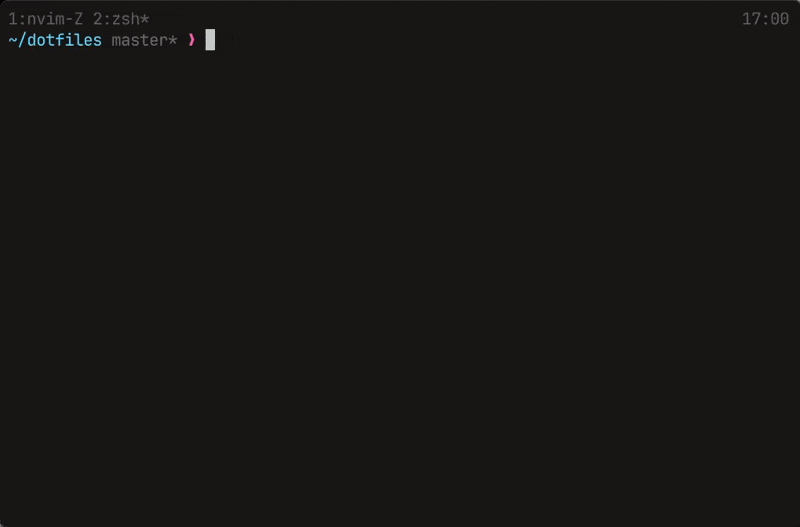Everytime I set up a new [Mac]hine, I spend a lot of time (up to 1 day) configuring it. I decided to automate this process and make it easier for me to set up my development environment. And it definitely worked! Now I can set up my Mac in less than 10 minutes.
 [Dotfiles setup in just several clicks]
[Dotfiles setup in just several clicks]
Introduction
2 years ago I started using neovim as my main editor and
I wanted to have a way to keep my configuration files in sync as I often switch
between different machines. Since then I've just created a git
repository with my configuration.
It's been working fine, when I need to set up a new machine I just clone the
repository to ~/.config/nvim (I'm using unix-like os) and I'm good to go with
all my plugins and settings.
I'm too lazy for this
Over time, I started using more CLI tools, and my dotfiles collection kept growing. Each tool had its own configuration files that I wanted to keep in sync, which became a bit of a pain. Managing and installing everything on a new machine wasn’t difficult, but it was definitely time-consuming. I had to find and install each tool, then manually copy over the configuration files to the right locations. The last time I set up a new machine from scratch, it ended up taking me a few hours to get everything in place... So, probably it was time to automate this process.
In this post, I'll share how I manage my dotfiles and give you some tips on how to do it better. Also, you can check out [what tools I use in my daily work].
Dotfiles management
1. Dotfiles repository
First of all, you need to create a git repository to store your dotfiles. It will help you to keep track of changes and easily sync them across different machines.
2. Symlinks
The idea is to create symlinks from the dotfiles in your repository to the actual files in your home directory. This way, you can keep all your configuration files in one place and easily sync them across different machines.
Example: Let's say you have a
.zshrcfile in your dotfiles repository. To create a symlink to this file in your home directory, you can run the following command:ln -s ~/<path_to_your_dotfiles>/.zshrc ~/.zshrcIt will create a symlink from
~/.zshrcto~/<path_to_your_dotfiles>/.zshrc. Any changes you make to the.zshrcfile in your dotfiles repository will be reflected in the symlinked file in your home directory.
Hooray, you no longer need to manually copy over configuration files every time you set up or change something!
3. Brewfile
If you're using Homebrew on MacOS, you can create a
Brewfile to list all the packages you want to install. This way, you can
easily install all the necessary tools with a single command.
Example: Here's an example
Brewfilethat lists some of the tools I use:... # Basic brew "git" brew "gh" brew "wget" brew "tree" brew "bat" # CLI tools brew "tmux" brew "lazydocker" brew "lazygit" brew "neovim" brew "fzf" brew "ripgrep" ...
To install all the packages listed in the Brewfile, you can run the following
command:
brew bundle install --file=Brewfile
4. Installation script
This is where the magic happens. You can create an installation script that automates the process of setting up your development environment. The script should install all the necessary tools and create symlinks for your dotfiles.
Example: Here's a simple installation script that installs (symlinks) all my dotfiles:
#!/bin/bash
# Define what dotfiles to link
DOTFILES_TO_LINK=(
bin
.config
.tmux
.tmux.conf
.zshrc
.hushlogin
.gitconfig
.gitignore_global
)
# Links each file from the dotfiles repository to the home directory
link_file () {
local src=$1 dst=$2
base_dst=$(basename "$dst")
if [ -e "$dst" ]; then
if ask_user "$HOME/$base_dst already exists in your system. Overwrite it? [y/n]"; then
rm -rf "$dst"
else
info "skipped $base_dst"
return
fi
fi
ln -sf "$src" "$dst"
success "linked $base_dst"
}
# Install dotfiles
install_dotfiles () {
if ! ask_user "Do you want to link dotfiles? [y/n]"; then
info "skipped linking dotfiles"
return
fi
info "Linking dotiles"
for file in "${DOTFILES_TO_LINK[@]}"; do
link_file "$DOTFILES_ROOT/$file" "$HOME/$file"
done
success "dotfiles linked"
}
This is only a part of my installation script. I have also other things:
- Installation MacOS applications using brew
- Installation of MacOS settings
- Installation of zsh and oh-my-zsh with plugins
- Installation other tools like tmux, fzf, etc.
You can check out the full scripts in my dotfiles
repository (/scripts folder).
Conclusion
I spent a lot of time setting up my development environment. I like to explore new tools and configurations, and I am really glad that I have found a way to automate this process!